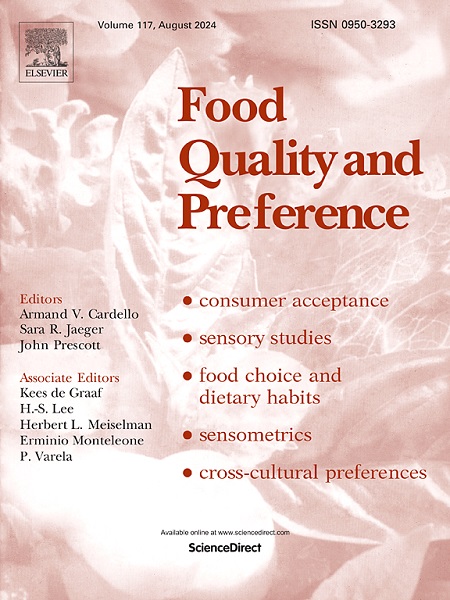Investigating consumer heterogeneity in multiblock L-shape data by combining SO-PLS regression and two-step procedure
IF 4.9
1区 农林科学
Q1 FOOD SCIENCE & TECHNOLOGY
引用次数: 0
Abstract
This manuscript proposes, for the first time, a new way to analyse L-shape data by combining the Sequential and Orthogonalized – Partial Least Square (SO-PLS) regression, and the Two-step PLS based Procedure (TSP) approach in the so called Sequential and Orthogonalized – Two Step Procedure (SO-TSP) approach. In a sensory and consumer study conducted in Norway, two blocks of sensory properties data (i.e. beginning, and middle-end of eating process), one block of consumer preferences liking data, and two blocks of consumer attributes data (i.e. health, and taste) were collected. Data were analysed in two steps. In step 1, consumer liking data are regressed onto sensory properties at the beginning and middle-end of eating process using the SO-PLS regression. Then, consumers were then segmented according to the Principal Components of Predictions (PCP) correlation. In step 2 consumer dummy variables, which represent two segments from step 1, are regressed onto the two consumer attributes blocks data (i.e. attitudes to taste and healthiness) using SO-PLS regression. These findings demonstrate that the SO-TSP approach is a useful and flexible tool to investigate and understand the complex relations among consumer segments, and the different blocks of dynamic sensory properties, and different types of consumer attributes data. Methodological implications and recommendations for academia, and future research avenues are discussed and outlined.
结合SO-PLS回归和两步法研究多块l形数据中的消费者异质性
本文首次提出了一种分析l形数据的新方法,该方法结合了顺序和正交化偏最小二乘(so -PLS)回归和基于两步PLS的过程(TSP)方法,即所谓的顺序和正交化两步过程(so -TSP)方法。在挪威进行的一项感官和消费者研究中,收集了两块感官特性数据(即进食过程的开始和中期)、一块消费者偏好喜好数据和两块消费者属性数据(即健康和口味)。数据分析分两步进行。在第1步,消费者喜欢的数据回归到感官属性在开始和中期的饮食过程中使用SO-PLS回归。然后,根据预测的主成分(PCP)相关性对消费者进行细分。在步骤2中,使用SO-PLS回归,将表示步骤1中两个部分的消费者虚拟变量回归到两个消费者属性块数据(即对味道和健康的态度)。这些发现表明,SO-TSP方法是一种有用且灵活的工具,可以研究和理解消费者群体之间的复杂关系,以及不同类型的动态感官属性块和不同类型的消费者属性数据。讨论并概述了对学术界的方法影响和建议,以及未来的研究途径。
本文章由计算机程序翻译,如有差异,请以英文原文为准。
求助全文
约1分钟内获得全文
求助全文
来源期刊

Food Quality and Preference
工程技术-食品科技
CiteScore
10.40
自引率
15.10%
发文量
263
审稿时长
38 days
期刊介绍:
Food Quality and Preference is a journal devoted to sensory, consumer and behavioural research in food and non-food products. It publishes original research, critical reviews, and short communications in sensory and consumer science, and sensometrics. In addition, the journal publishes special invited issues on important timely topics and from relevant conferences. These are aimed at bridging the gap between research and application, bringing together authors and readers in consumer and market research, sensory science, sensometrics and sensory evaluation, nutrition and food choice, as well as food research, product development and sensory quality assurance. Submissions to Food Quality and Preference are limited to papers that include some form of human measurement; papers that are limited to physical/chemical measures or the routine application of sensory, consumer or econometric analysis will not be considered unless they specifically make a novel scientific contribution in line with the journal''s coverage as outlined below.
 求助内容:
求助内容: 应助结果提醒方式:
应助结果提醒方式:


